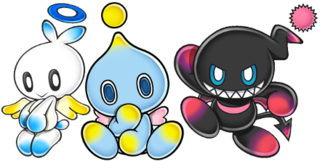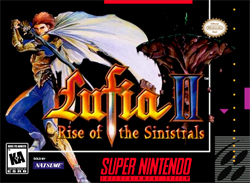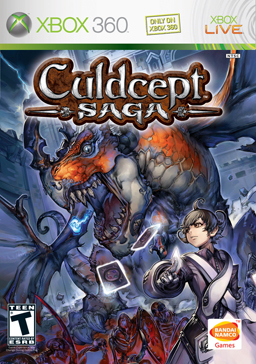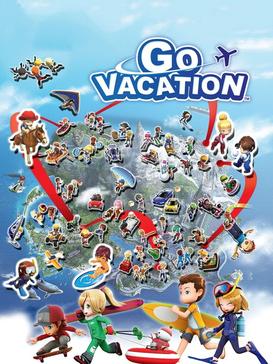
Chao are fictional life-forms in the Sonic the Hedgehog video game series published by Sega. They are small, childlike creatures that go through a complex life cycle and exist in several visual forms depending on how they are raised. Developer Sonic Team incorporated Chao into the games to encourage players to explore levels and support the good–evil dichotomy of Sonic Adventure 2.

Lufia II: Rise of the Sinistrals, known as Estpolis Denki II in Japan, and as Lufia in Europe and Australia, is a role-playing video game with puzzle elements developed by Neverland and published in Japan in 1995 by Taito, and in North America and Europe in 1996 by Natsume Inc. and Nintendo respectively, for the Super Nintendo Entertainment System. It is the second title in the Lufia series.

F-Zero GX is a 2003 racing video game developed by Amusement Vision and published by Nintendo for the GameCube console. It runs on an enhanced version of the engine used in Super Monkey Ball. F-Zero AX, the arcade counterpart of GX, uses the Triforce arcade system board conceived from a business alliance between Nintendo, Namco and Sega. Published by Sega, it was released alongside GX in 2003.

Sonic Shuffle is a Sonic the Hedgehog-themed party game developed and published by Sega for the Dreamcast in 2000. The game plays like a board game much in the same vein as Nintendo's Mario Party series, with up to four players moving their characters across a game board filled with a variety of spaces which can trigger different events. Some spaces will launch minigames that pit the players against each other in short competitive events.

Culdcept is a turn-based strategy video game, and the first game in the Culdcept series. It has drawn comparisons to other modern strategy titles, and also shares features with non-video games Monopoly and Magic: The Gathering. The game was initially released only in Japan for the Sega Saturn and PlayStation, but was ported to the Nintendo DS in 2008 as Culdcept DS.

Sega Soccer Slam, also known as simply Soccer Slam, is a sports game released for GameCube, Xbox, and PlayStation 2 in 2002.

Phantasy Star Online Episode III: C.A.R.D. Revolution is a turn-based role-playing video game released for the GameCube in 2003. It has a card-based play style, making it unique among games in the Phantasy Star Online series. The story of the game takes place twenty-one years after the fourth episode, itself set after the first two episodes.

Avatar: The Last Airbender: The Video Game is a 2006 action-adventure video game based on the animated television series of the same name. It was released for the Game Boy Advance, Microsoft Windows, GameCube, Nintendo DS, PlayStation 2, PlayStation Portable, Wii, and Xbox. The game was a launch title for the Wii in North America. All versions feature an original story set between Book 1 and Book 2 of the series, except for the Microsoft Windows version, which features a different story, based on Book 1, and different gameplay.

Culdcept Saga is a video game in the Culdcept series developed exclusively for the Xbox 360 video game console. It is the first entry for a Microsoft console in the franchise.
Magic Stones is a video game based on Celtic mythology and is a mix between a role-playing video game and a card game. It was developed by Winter Wolves and was released as shareware for the Macintosh and Windows platforms.

Avatar: The Game is a third-person action video game based on James Cameron's film Avatar. The game was developed by Ubisoft Montreal and released on the PlayStation 3, Xbox 360, Microsoft Windows, Wii and Nintendo DS on December 1, 2009, with a PSP version later released on December 7. It uses the same technology as the film to be displayed in stereoscopic 3D. As of May 19, 2010, the game has sold nearly 2.7 million copies.

The Munchables, known in Japan as Tabemon (たべモン), is an action-platform game developed by Now Production and published by Namco Bandai Games for the Wii video game console. The player controls the titular Munchables, creatures of insatiable appetite, who use their gurgitating prowess to consume enemies, which are known as "Tabemon Monsters", space pirates who have invaded the Munchables' home planet, known as Star Ving, and bear an uncanny resemblance to various foods.

Spore Hero Arena is a science fiction action-adventure game for the Nintendo DS and is a spin-off of Spore Hero which was released in North America on October 6, 2009, and worldwide on October 8. This game is the second Spore game for the Nintendo DS, and focuses more on battling than its predecessor, Spore Creatures. Creatures are now rendered in full 3D and the creature design system has been overhauled. The online functions/multiplayer were closed on 30 June 2014.

Crash Bandicoot Purple: Ripto's Rampage and Spyro Orange: The Cortex Conspiracy are two platform games published by Vivendi Universal Games. They are developed by Vicarious Visions for the Game Boy Advance. They were released in North America on June 3, 2004, and in Europe on June 25, 2004 under the names Crash Bandicoot Fusion and Spyro Fusion.
Dragon Quest is a series of role-playing video games that originated in 1986 with the release of the first game in the series. Although the games are not related in terms of story, many aspects of the gameplay are consistent throughout the series. Each game in the series add new elements to the gameplay, such as longer quests, character classes, or different ways of story-telling.
Treasure Isle is a defunct browser-based video game by Zynga for Facebook, launched in April 2010. It allowed users to dig for treasure on various islands. The game was discontinued on December 5, 2012.

Go Vacation is a 2011 party video game developed and released by Bandai Namco Games for the Wii and Nintendo Switch. It is the third game in the We Ski series. Up to four players can compete against each other in over 50 sport-based minigames that take place in four fictional island resorts. Minigames range from outdoor activities such as kayaking and horseback riding, to activities one might find in a city, like table hockey and minigolf. Different resorts can be accessed using vehicles such as trolleys and bicycles. Players can customize the outfit of their avatar and decorate their house with furniture.

Puzzle & Dragons is a puzzle video game with role-playing and strategy elements, developed and published by GungHo Online Entertainment for the iOS, Android, and Amazon Fire platforms.

A digital collectible card game (DCCG) or online collectible card game (OCCG) is a computer or video game that emulates collectible card games (CCG) and is typically played online or occasionally as a standalone video game. Many DCCGs are types of digital tabletop games and follow traditional card game-style rules, while some DCCGs use alternatives for cards and gameboards, such as icons, dice and avatars. Originally, DCCGs started out as replications of a CCG's physical counterpart, but many DCCGs have foregone a physical version and exclusively release as a video game, such as with Hearthstone.

Sonic Speed Simulator is a massively multiplayer online incremental platform game developed and published by Gamefam Studios, under license and in association with Sega of America, and serves as an official entry in the Sonic the Hedgehog franchise on the gaming and game development platform Roblox. The gameplay involves moving around and collecting Chaos Orbs to level up and increase speed and jumping power.















